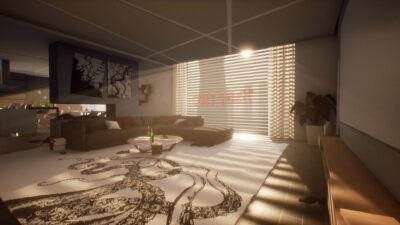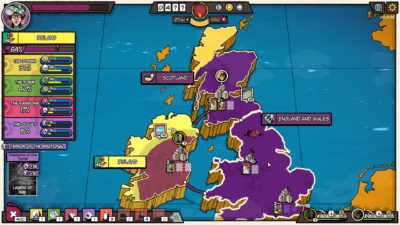
There’s a bit of a meme with The Kids these days, about people who don’t really play games much physically leaning and straining themselves – in real life – to aid in-game performance.
Now, ignoring the fact we all did this on Mario Kart at one point or another, the intent is simple: to highlight that those not ‘into’ games aren’t as cool and comfortable as the extremeperts (“extreme experts”) who sit in stony, unmoving silence as they blitz their way through any challenge put in front of them.
I have been playing games for 30-something years, so consider myself one of those extremeperts. Ultrakill nearly made me fall out of my chair I was leaning and straining so much.
It’s just. So. Pacey. It’s an FPS that remembers the genre from the mid-1990s as full of quick-footed games, but didn’t actually check how fast they were. So instead of it feeling like Duke Nukem 3D or Quake, it feels like something much faster. In a regular FPS that would be a bit much, but Ultrakill mixes things up by plopping it into Unity and adding a dash of Devil May Cry. Yes, the third-person action-adventure series from Capcom. Bear with.
“Devil May Cry is probably the most important [influence] for the project, as much as it may come as a surprise,” explains Arsi “Hakita” Patala, creator of Ultrakill. “I always wanted to make Ultrakill more of a ‘What if DMC was an FPS?’ than ‘What if an FPS had DMC elements?’, but as it turns out, DOOM (both classic and the new ones) shares a lot of game design philosophy with character action games, which really made it into a natural fit.”
The initial idea for the game, however, involved no Devil May Cry – in fact, it hardly involved any game at all, coming as it did from a design course assignment in which Patala was asked to craft a main menu for a made-up video game. “My fake game idea was to have the most absurd balls-to-the-wall FPS, and I wanted to give it a fittingly absurd and blunt name,” he says.
“So I followed the Japanese naming convention of just mashing together two cool English words, even if it ends up not making any sense, and came up with ULTRAKILL (in caps for extra impact).” Work on Ultrakill didn’t start for a while, with a foray into designing a Metal Gear Solid-alike abandoned before moving onto the over-the-top FPS: “I took [the design course assignment] as the base and started putting in all the fun things I could think of: fast pace, extreme popcorn violence, complete focus on non-stop gameplay, a style meter, emphasis on player expression, etc. And over time it shaped into what Ultrakill is today.”
 3_.jpg” alt=”” width=”1920″ height=”1080″ />
3_.jpg” alt=”” width=”1920″ height=”1080″ />Your run-of-the-mill husks can do serious damage if you let them overwhelm you, or if you stand still for, say, half a second.
The style meter is fed by your combos – chaining kills together, bagging headshots, taking out multiple enemies from a wave in one shot, making trick shots, and much more. Stringing these abilities together builds up your combo meter, which builds up your multiplier, which leads to higher scores – good for both boasting about and for buying new weapons and equipment as the game pro-gresses.
On playing Ultrakill, it immediately feels right – there have been combo systems and speedruns in shooters before, but this one has a different impact to it, be it thanks to the pace, the visuals, or the intangible feel of the game.
“A good combo system is one that both gives players enough freedom to build their own variation of the game’s preferred playstyle while also encouraging them to not get complacent or rely on the path of least resistance,” Patala says.
“The style system is great for immediate and constant feedback on the player’s performance as well as pushing them to vary things up without forcing them to. Every player is different, so giving them some wiggle room is important to keep them engaged and make sure they’re having as much fun as possible.” This stretches to things like allowing players to switch weapons at any point – it might mean cancelling out of an animation, thus making things look a bit janky, but keeping the flow is more important.
 1_.jpg” alt=”” width=”1920″ height=”1080″ />
1_.jpg” alt=”” width=”1920″ height=”1080″ />You can’t quite see the pace here, given it’s a static image, so just imagine it instead.
Ultrakill is currently available through Early Access, with a launch looking to land either later this year or early next. EA is useful for Patala, who gets direct feedback from those who matter the most: the players. “The best part of getting player feedback during development is that, as a developer, you already know how the game is supposed to be played,” he says.
“So you tend to miss out on a lot of design problems, errors, and bugs that the average player is likely to run into… It’s a lot more fun to do things when you get to hear [what] players enjoy. Sometimes all it takes to get out of a rut is to see a meme or piece of fan art that someone put effort into making just because they liked what you’ve made.”
There’s negative feedback, of course, but generally speaking, it’s a positive experience for the developer, who is largely working alone on Ultrakill. Help comes with elements like models and other art assets, as well as more complex systems coding. “I always make sure to be a part of all of it though, to ensure the game continues to have a consistent direction and vision,” says Patala.
“For me, this is the ideal way to make the kinds of games I want to make,” he continues, “since this means I retain full control of the project while still being able to rely on people who are better at some things than I am. My development style tends to be improvisational and impulsive, which would be far too messy, if not completely impossible, with a large team.”
Genre: Fast-paced FPS
Format: PC
Developer: Arsi “Hakita” Patala
Publisher: New Blood Interactive
Release: Out now (Early Access)





